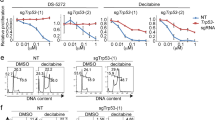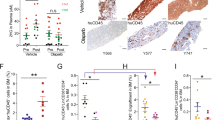Abstract
Anti-tumor cellular immunotherapies that implement a suicide gene system can limit potential undesirable effects. In a haplo-identical bone marrow transplant clinical trial, over 90% of iCaspase-9-expressing cells were eradicated after AP1903 exposure, and signs of graft-versus-host disease disappeared. Nevertheless, low numbers of genetically modified T cells survived this treatment. We studied genetically modified cell lines (GMCL) that carried a dual iCaspase-9/ΔCD19 DNA construct (ΔCD19=truncated CD19). With AP1903 exposure, a low percentage of cells (1.47±0.67%; n=5 replications) persisted in vitro. Repeated exposures to increasing AP1903 doses generated low (GMCLLR) and high AP1903-responders (GMCLHR), which expressed different levels of surface ΔCD19 and intracellular iCaspase-9. Compared with GMCLHR, GMCLLR exhibited higher methylation of 5′-long-terminal repeat (LTR) promoters, both in the number of sequences with at least one methylated CpG (16 vs 51.5%, respectively) and in the number of CpG islands (1.2 vs 8.9%, respectively). Four days of 5-azacytidine exposure reduced methylation and increased ΔCD19 and iCaspase-9 expression. Interestingly, LTR demethylation restored GMCLLR sensitivity to AP1903 by 24.3-fold (1.8 vs 43.8%) without affecting GMCLHR. We showed that 5′-LTR-methylation inhibited transgene expression and caused AP1903 hypo-responsiveness. Treating with a hypomethylating agent restored AP1903 sensitivity. This approach can be applied in further clinical trials to improve iCaspase-9 response if low response is detected.
This is a preview of subscription content, access via your institution
Access options
Subscribe to this journal
Receive 12 print issues and online access
$259.00 per year
only $21.58 per issue
Buy this article
- Purchase on Springer Link
- Instant access to full article PDF
Prices may be subject to local taxes which are calculated during checkout






Similar content being viewed by others
References
Appelbaum FR . Haematopoietic cell transplantation as immunotherapy. Nature 2001; 411: 385–389.
Bonini C, Ferrari G, Verzeletti S, Servida P, Zappone E, Ruggieri L et al. HSV-TK gene transfer into donor lymphocytes for control of allogeneic graft-versus-leukemia. Science 1997; 276: 1719–1724.
Tiberghien P, Cahn JY, Brion A, Deconinck E, Racadot E, Herve P et al. Use of donor T-lymphocytes expressing herpes-simplex thymidine kinase in allogeneic bone marrow transplantation: a phase I-II study. Hum Gene Ther 1997; 8: 615–624.
Marin V, Cribioli E, Philip B, Tettamanti S, Pizzitola I, Biondi A et al. Comparison of different suicide-gene strategies for the safety improvement of genetically manipulated T cells. Hum Gene Ther Methods 2012; 23: 376–386.
Introna M, Barbui AM, Bambacioni F, Casati C, Gaipa G, Borleri G et al. Genetic modification of human T cells with CD20: a strategy to purify and lyse transduced cells with anti-CD20 antibodies. Hum Gene Ther 2000; 11: 611–620.
Bonini C, Grez M, Traversari C, Ciceri F, Marktel S, Ferrari G et al. Safety of retroviral gene marking with a truncated NGF receptor. Nat Med 2003; 9: 367–369.
Ciceri F, Bonini C, Marktel S, Zappone E, Servida P, Bernardi M et al. Antitumor effects of HSV-TK-engineered donor lymphocytes after allogeneic stem-cell transplantation. Blood 2007; 109: 4698–4707.
Ciceri F, Bonini C, Stanghellini MT, Bondanza A, Traversari C, Salomoni M et al. Infusion of suicide-gene-engineered donor lymphocytes after family haploidentical haemopoietic stem-cell transplantation for leukaemia (the TK007 trial): a non-randomised phase I-II study. Lancet Oncol 2009; 10: 489–500.
Tiberghien P, Ferrand C, Lioure B, Milpied N, Angonin R, Deconinck E et al. Administration of herpes simplex-thymidine kinase-expressing donor T cells with a T-cell-depleted allogeneic marrow graft. Blood 2001; 97: 63–72.
Di Stasi A, Tey SK, Dotti G, Fujita Y, Kennedy-Nasser A, Martinez C et al. Inducible apoptosis as a safety switch for adoptive cell therapy. N Engl J Med 2011; 365: 1673–1683.
Straathof KC, Pule MA, Yotnda P, Dotti G, Vanin EF, Brenner MK et al. An inducible caspase 9 safety switch for T-cell therapy. Blood 2005; 105: 4247–4254.
Tey SK, Dotti G, Rooney CM, Heslop HE, Brenner MK . Inducible caspase 9 suicide gene to improve the safety of allodepleted T cells after haploidentical stem cell transplantation. Biol Blood Marrow Transplant 2007; 13: 913–924.
Coito S, Sauce D, Duperrier A, Certoux JM, Bonyhadi M, Collette A et al. Retrovirus-mediated gene transfer in human primary T lymphocytes induces an activation- and transduction/selection-dependent TCR-B variable chain repertoire skewing of gene-modified cells. Stem Cells Dev 2004; 13: 71–81.
Sauce D, Tonnelier N, Duperrier A, Petracca B, de Carvalho Bittencourt M, Saadi M et al. Influence of ex vivo expansion and retrovirus-mediated gene transfer on primary T lymphocyte phenotype and functions. J Hematother Stem Cell Res 2002; 11: 929–940.
Sauce D, Bodinier M, Garin M, Petracca B, Tonnelier N, Duperrier A et al. Retrovirus-mediated gene transfer in primary T lymphocytes impairs their anti-Epstein-Barr virus potential through both culture-dependent and selection process-dependent mechanisms. Blood 2002; 99: 1165–1173.
Sauce D, Mercier P, Battini JL, Ferrand C, Certoux JM, Manel N et al. Preferential retroviral-mediated transduction of EBV- and CMV-specific T cells after polyclonal T-cell activation. Gene Ther 2004; 11: 1019–1022.
Ferrand C, Robinet E, Contassot E, Certoux JM, Lim A, Herve P et al. Retrovirus-mediated gene transfer in primary T lymphocytes: influence of the transduction/selection process and of ex vivo expansion on the T cell receptor beta chain hypervariable region repertoire. Hum Gene Ther 2000; 11: 1151–1164.
Deschamps M, Robinet E, Certoux JM, Mercier P, Sauce D, De Vos J et al. Transcriptome of retrovirally transduced CD8+ lymphocytes: influence of cell activation, transgene integration, and selection process. Mol Immunol 2008; 45: 1112–1125.
Sauce D, Rufer N, Mercier P, Bodinier M, Remy-Martin JP, Duperrier A et al. Retrovirus-mediated gene transfer in polyclonal T cells results in lower apoptosis and enhanced ex vivo cell expansion of CMV-reactive CD8 T cells as compared with EBV-reactive CD8 T cells. Blood 2003; 102: 1241–1248.
Mercier-Letondal P, Deschamps M, Sauce D, Certoux JM, Milpied N, Lioure B et al. Early immune response against retrovirally transduced herpes simplex virus thymidine kinase-expressing gene-modified T cells coinfused with a T cell-depleted marrow graft: an altered immune response? Hum Gene Ther 2008; 19: 937–950.
Traversari C, Marktel S, Magnani Z, Mangia P, Russo V, Ciceri F et al. The potential immunogenicity of the TK suicide gene does not prevent full clinical benefit associated with the use of TK-transduced donor lymphocytes in HSCT for hematologic malignancies. Blood 2007; 109: 4708–4715.
Garin MI, Garrett E, Tiberghien P, Apperley JF, Chalmers D, Melo JV et al. Molecular mechanism for ganciclovir resistance in human T lymphocytes transduced with retroviral vectors carrying the herpes simplex virus thymidine kinase gene. Blood 2001; 97: 122–129.
Deschamps M, Mercier-Lethondal P, Certoux JM, Henry C, Lioure B, Pagneux C et al. Deletions within the HSV-tk transgene in long-lasting circulating gene-modified T cells infused with a hematopoietic graft. Blood 2007; 110: 3842–3852.
Iuliucci JD, Oliver SD, Morley S, Ward C, Ward J, Dalgarno D et al. Intravenous safety and pharmacokinetics of a novel dimerizer drug, AP1903, in healthy volunteers. J Clin Pharmacol 2001; 41: 870–879.
Spencer DM, Wandless TJ, Schreiber SL, Crabtree GR . Controlling signal transduction with synthetic ligands. Science 1993; 262: 1019–1024.
Fan L, Freeman KW, Khan T, Pham E, Spencer DM . Improved artificial death switches based on caspases and FADD. Hum Gene Ther 1999; 10: 2273–2285.
Zhong B, Watts KL, Gori JL, Wohlfahrt ME, Enssle J, Adair JE et al. Safeguarding nonhuman primate iPS cells with suicide genes. Mol Ther 2011; 19: 1667–1675.
Casucci MF, Nicolis di Robilant L, Dual B . Transgenesis of T cells with a novel CD44v6-specific chimeric antigen receptor and a suicide gene for safe and effective targeting of chemoresistance in hematopoietic tumors. Blood 2011; 2: 378–382.
Budde LE, Berger C, Lin Y, Wang J, Lin X, Frayo SE et al. Combining a CD20 Chimeric Antigen Receptor and an Inducible Caspase 9 Suicide Switch to Improve the Efficacy and Safety of T Cell Adoptive Immunotherapy for Lymphoma. PLoS One 2013; 8: e82742.
Ramos CA, Asgari Z, Liu E, Yvon E, Heslop HE, Rooney CM et al. An inducible caspase 9 suicide gene to improve the safety of mesenchymal stromal cell therapies. Stem Cells 2010; 28: 1107–1115.
Suntharalingam G, Perry MR, Ward S, Brett SJ, Castello-Cortes A, Brunner MD et al. Cytokine storm in a phase 1 trial of the anti-CD28 monoclonal antibody TGN1412. N Engl J Med 2006; 355: 1018–1028.
Di Ianni M, Terenzi A, Perruccio K, Ciurnelli R, Lucheroni F, Benedetti R et al. 5-Azacytidine prevents transgene methylation in vivo. Gene Ther 1999; 6: 703–707.
Choi J, Ritchey J, Prior JL, Holt M, Shannon WD, Deych E et al. In vivo administration of hypomethylating agents mitigate graft-versus-host disease without sacrificing graft-versus-leukemia. Blood 2010; 116: 129–139.
de Lima M, Giralt S, Thall PF, de Padua Silva L, Jones RB, Komanduri K et al. Maintenance therapy with low-dose azacitidine after allogeneic hematopoietic stem cell transplantation for recurrent acute myelogenous leukemia or myelodysplastic syndrome: a dose and schedule finding study. Cancer 2010; 116: 5420–5431.
Goodyear OC, Dennis M, Jilani NY, Loke J, Siddique S, Ryan G et al. Azacitidine augments expansion of regulatory T cells after allogeneic stem cell transplantation in patients with acute myeloid leukemia (AML). Blood 2012; 119: 3361–3369.
Kim JH, Lee SR, Li LH, Park HJ, Park JH, Lee KY et al. High cleavage efficiency of a 2 A peptide derived from porcine teschovirus-1 in human cell lines, zebrafish and mice. PLoS One 2011; 6: e18556.
Bonini C, Bondanza A, Perna SK, Kaneko S, Traversari C, Ciceri F et al. The suicide gene therapy challenge: how to improve a successful gene therapy approach. Mol Ther 2007; 15: 1248–1252.
Herbst F, Ball CR, Tuorto F, Nowrouzi A, Wang W, Zavidij O et al. Extensive methylation of promoter sequences silences lentiviral transgene expression during stem cell differentiation in vivo. Mol Ther 2012; 20: 1014–1021.
Jabbour E, Giralt S, Kantarjian H, Garcia-Manero G, Jagasia M, Kebriaei P et al. Low-dose azacitidine after allogeneic stem cell transplantation for acute leukemia. Cancer 2009; 115: 1899–1905.
Plumb JA, Strathdee G, Sludden J, Kaye SB, Brown R . Reversal of drug resistance in human tumor xenografts by 2′-deoxy-5-azacytidine-induced demethylation of the hMLH1 gene promoter. Cancer Res 2000; 60: 6039–6044.
Sutherland MK, Yu C, Anderson M, Zeng W, van Rooijen N, Sievers EL et al. 5-azacytidine enhances the anti-leukemic activity of lintuzumab (SGN-33) in preclinical models of acute myeloid leukemia. MAbs 2010; 2: 440–448.
Rohde C, Zhang Y, Reinhardt R, Jeltsch A . BISMA—fast and accurate bisulfite sequencing data analysis of individual clones from unique and repetitive sequences. BMC Bioinformatics 2010; 11: 230.
Acknowledgements
We thank Pr Malcolm Brenner (Center for Cell and Gene Therapy, Baylor College of Medicine, Houston, USA) for providing research grade of packaging cell line and retroviral supernatant. We also thank Pr David Spencer (Bellicum Pharmaceuticals, Houston, USA) for providing research grade AP1903 Chemical Inducer Dimerizer and for revising this manuscript. This study was supported by the ‘Programme Hospitalier de Recherche Clinique’ (PHRC #950898), the ‘Ligue Nationale contre le Cancer’ (2013), Etablissement Français du sang (APR 2013) and Région de Franche-Comté (Grant 2013); it was co-funded, in part, by the 2013/A02 tender of the Association Capucine and the Société Française de Greffe de Moelle—Thérapie Cellulaire (SFGM-TC).
Author contributions
EB-R executed all experiments, including cell cultures, flow cytometry and western blotting, and she wrote the original draft of the manuscript. CG, II and J-MC assisted with retroviral transductions, GMTC production and AP1903 resistance. A-MM, PT and CB contributed to improving the manuscript and provided final approval. ED and FL provided relevant information of clinical interest and information on future clinical trials. CF and MD initiated and designed the study, participated in every step of the study, managed the whole project and wrote the manuscript.
Author information
Authors and Affiliations
Corresponding author
Ethics declarations
Competing interests
The authors declare no conflict of interest.
Additional information
Supplementary Information accompanies this paper on Gene Therapy website
Supplementary information
Rights and permissions
About this article
Cite this article
Bôle-Richard, E., Gamonet, C., Certoux, JM. et al. Exposure to hypomethylating agent, 5-azacytidine, may improve iCasp9 suicide gene therapy for treating GvHD in allografts. Gene Ther 23, 664–672 (2016). https://doi.org/10.1038/gt.2016.39
Received:
Revised:
Accepted:
Published:
Issue Date:
DOI: https://doi.org/10.1038/gt.2016.39



